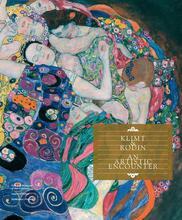More about Virgin
- All
- Info
- Shop

Contributor
Klimt’s portrayal of a woman that was sexual, but non-threatening was virgin territory to him.
The Virgin (also known as The Maiden) is a prime example of Klimt’s departure from his gold period that produced paintings like The Kiss and Adele Bloch-Bauer. Inspired by the colorful and emotionally expressive works of Munch, Matisse, Toulouse-Lautrec, and the Fauves, Klimt opted for a kaleidoscopic style that favored the figures at the center of his paintings. Klimt decided gold was too rigid to communicate true emotion to his audience, and his new use of pure, vibrant color drew attention toward his paintings’ subjects rather than away.
This period also marked the time when Klimt began using narrative in his paintings. In The Virgin, a sleeping girl dreams about her sexual awakening, which apparently involves multiple naked women surrounding her in an orgy-esque formation. Talk about kinky! The women around her are supposed to represent different stages of life though it’s unclear what exactly each one represents.
But without that weirdly specific context The Virgin could easily be interpreted as a young woman dreaming about getting it on with other women, making way for a homoerotic interpretation of the painting. However you interpret the painting, one thing is certain: men don’t populate this virgin’s fantasies at all. Even male viewers of the painting are immediately distanced from her, placed in a voyeuristic position where they can look but can’t touch.
Klimt often depicted women as sex symbols though they usually took the form of a dangerously seductive femme fatale. He took careful steps to express the virgin’s sexuality while still maintaining her innocence. Even if the painting doesn’t seem sensual enough at first glance- “I mean, it’s called The Virgin, not Promiscuous ft. Timbaland!”- the placement of the virgin’s head suggests the overall composition is meant to take the shape of a vulva. Additionally, a preliminary sketch reveals that Klimt intended the titular character to openly display her vagina. Despite being a man, and a rather womanizing one at that, Klimt understood that just because a woman is a virgin doesn’t mean she’s out of touch with her desires.
This was one of the last paintings Klimt completed before he died in 1918. He left behind an unfinished painting titled The Bride that was meant to be a companion piece to The Virgin. In The Bride our maiden awakes from her wet dream to get married and hopefully receive some vitamin D on her honeymoon. We love a happy ending!
Sources
- Gilles Néret, Gustav Klimt: 1862-1918 (Germany: Barnes and Nobles Book, 2001), 67, 71,74.
- Laura Payne, Essential Klimt (Bath, UK: Parragon Publishing, 2000), 215.
- Eva di Stefano, Gustav Klimt: Art Nouveau Visionary (New York: Sterling Publishing, 2008), 224.
- “The Virgin by Gustav Klimt Loaned to San Francisco,” National Gallery of Prague August 8, 2017.
Featured Content
Here is what Wikipedia says about The Maiden (Klimt)
The Maiden (German: Die Jungfrau) is a painting by the Austrian painter Gustav Klimt painted in 1913. The Maiden was one of Klimt's last paintings before he died. Currently it is stored in the National Gallery in Prague, Czech Republic.
Check out the full Wikipedia article about The Maiden (Klimt)


















